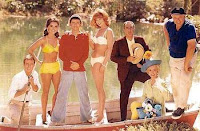I’d thought of making an I Dream of Jeannie joke about this post title, but then I heard that actor Michael Ansara had died and it felt like it might be in poor taste. He was Barbara Eden’s husband for a while, and even played another genie on the show once. Of course, he’s really famous for playing Commander Kang, arguably the Klingon (sorry, Michael Dorn), on no less than three different Star Trek shows across more than thirty years, starring in countless westerns, a famous Outer Limits episode, and also for being the voice of Mr. Freeze for the animated Batman and Batman Beyond. In short… he was awesome and it’s sad that he’s gone.
However…
 By odd coincidence, one of the first places I heard the phrase “bottle show” was when I was researching screenplays for Star Trek. A bottle show was what they called an episode that used only existing sets and costumes, and often only the regular cast with minimal (if any) guest stars. The producers loved them because they saved money, which also made them a great way for aspiring writers to get in. Write a solid bottle show and they’d buy it just so they could have it handy for emergencies, or to help counterbalance two or three expensive episodes in a row.
By odd coincidence, one of the first places I heard the phrase “bottle show” was when I was researching screenplays for Star Trek. A bottle show was what they called an episode that used only existing sets and costumes, and often only the regular cast with minimal (if any) guest stars. The producers loved them because they saved money, which also made them a great way for aspiring writers to get in. Write a solid bottle show and they’d buy it just so they could have it handy for emergencies, or to help counterbalance two or three expensive episodes in a row. And in a way, a lot of the bottle episodes tended to be better stories. Once the writers didn’t have the distraction of the “alien of the week,” they could focus their efforts on either bringing out new aspects of their cast or weaving a much more elaborate story. By limiting what could be done with one aspect of the storytelling, it made all the other aspects that much stronger.
And that kind of makes sense, doesn’t it? Unlimited situations don’t have any tension. If my characters have unlimited time to solve a problem, or have unlimited space to get away from it, my story isn’t going to be very interesting.
The thing is, being “in the bottle” could refer to any sort of restriction. It could be a limited location, yes, like those Star Trek episodes or a good haunted house tale or the classic Campbell story “Who Goes There,” which most of you probably know better as The Thing. Most of George Romero’s zombie movies are bottle stories, too, with people trapped in a farmhouse, a mall, an underground complex, and so on.
But it could also be a time limit, that famous ticking clock. It doesn’t matter what the character does or doesn’t do, the story is ending in two weeks, or two days, or maybe just two hours. Many of Arthur C. Clarke’s stories involve ticking clocks (often on an astronomical scale, but they’re there)
Laughable as it may sound, Speed is a bottle story. The limit is actually the minimum speed the bus could travel. That’s what created all the tension, because screenwriter Graham Yost came up with a very clever bottle for his story.
If you’ve having trouble with a story, try sticking it in a bottle. Rather than trying to make it big and expansive and epic, figure out how it can be tight and restricted and personal. Slap a limit on it. Confine your characters to a few locations. Figure out some way to restrict their time. Or even just stick to one viewpoint. If I see and hear everything through Yakko, it means I don’t know what’s going on in Wakko’s head or where Dot was during that blackout.
As I’ve mentioned before, one of the key elements of any challenge is that it has to be faced. If I can avoid facing it because of a lack of limits—letting me get away from it, postpone it, or even massively overpower it—then it isn’t really much of a challenge. And if there isn’t much of a challenge, there isn’t much of a story.
Next time, I think it’s important that we all admit a few things.
Until then, go write.






